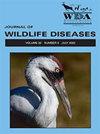Doxapram可提高驼鹿(Alces Alces)麻醉所致低氧血症的补氧可靠性。
IF 1.2
4区 农林科学
Q3 VETERINARY SCIENCES
引用次数: 0
摘要
药物性低氧血症可在自由生活的驼鹿(Alces Alces)固定时发生。我们描述了12名用噻芬太尼和噻嗪固定的成年女性的生理反应,并在前(预处理)和后(治疗后)鼻补氧(4l /min)加或不加静脉doxapram后出现低氧血症的临床症状。本文章由计算机程序翻译,如有差异,请以英文原文为准。
Doxapram May Improve Reliability of Oxygen Supplementation for Treatment of Anesthesia-Induced Hypoxemia of Moose (Alces alces).
Drug-induced hypoxemia can occur with the immobilization of free-living moose (Alces alces). We describe the physiologic response of 12 adult females immobilized with thiafentanil and xylazine and exhibiting clinical signs of hypoxemia before (pretreatment) and after (posttreatment) nasal oxygen supplementation (4 L/min) with or without intravenous doxapram.
求助全文
通过发布文献求助,成功后即可免费获取论文全文。
去求助
来源期刊

Journal of Wildlife Diseases
农林科学-兽医学
CiteScore
2.70
自引率
0.00%
发文量
213
审稿时长
6-16 weeks
期刊介绍:
The JWD publishes reports of wildlife disease investigations, research papers, brief research notes, case and epizootic reports, review articles, and book reviews. The JWD publishes the results of original research and observations dealing with all aspects of infectious, parasitic, toxic, nutritional, physiologic, developmental and neoplastic diseases, environmental contamination, and other factors impinging on the health and survival of free-living or occasionally captive populations of wild animals, including fish, amphibians, reptiles, birds, and mammals. Papers on zoonoses involving wildlife and on chemical immobilization of wild animals are also published. Manuscripts dealing with surveys and case reports may be published in the Journal provided that they contain significant new information or have significance for better understanding health and disease in wild populations. Authors are encouraged to address the wildlife management implications of their studies, where appropriate.
 求助内容:
求助内容: 应助结果提醒方式:
应助结果提醒方式:


